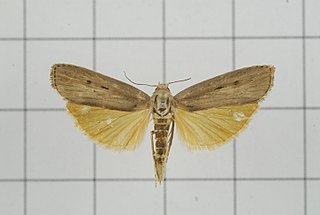
The Pyralidae, commonly called pyralid moths, snout moths or grass moths, are a family of Lepidoptera in the ditrysian superfamily Pyraloidea. In many classifications, the grass moths (Crambidae) are included in the Pyralidae as a subfamily, making the combined group one of the largest families in the Lepidoptera. The latest review by Eugene G. Munroe & Solis, in Kristensen (1999) retains the Crambidae as a full family of Pyraloidea.

The Pyraloidea are a moth superfamily containing about 16,000 described species worldwide, and probably at least as many more remain to be described. They are generally fairly small moths.

The Pyralinae are the typical subfamily of snout moths and occur essentially worldwide, in some cases aided by involuntary introduction by humans. They are rather rare in the Americas however, and their diversity in the Australian region is also limited. Altogether, this subfamily includes about 900 described species, but new ones continue to be discovered. Like many of their relatives in the superfamily Pyraloidea, the caterpillar larvae of many Pyralinae – and in some cases even the adults – have evolved the ability to use unusual foods for nutrition; a few of these can become harmful to humans as pests of stored goods.

Elophila nymphaeata, the brown china mark, is a species of moth of the family Crambidae. It was described by Carl Linnaeus in his 1758 10th edition of Systema Naturae. It is found in Europe. The moth is notable as its larva, like most members of the crambid subfamily Acentropinae, is aquatic and has tracheal gills.

Homoeosoma nimbella is a moth of the family Pyralidae. It is found in Europe.

Pyralis regalis is a species of snout moth. It is found from most of Europe east to Asia, including China, Cambodia, Myanmar, India, Russia, Korea, Japan and Taiwan.

The Phycitini are a tribe of moths of the family Pyralidae.

The Anerastiini are a tribe of moths of the family Pyralidae.

Selagia spadicella is a species of snout moth. It is found in most of Europe, as well as in Turkey and North Africa.

Rhodophaea formosa is a moth of the family Pyralidae. It is found in most of Europe.

Phycitodes albatella is a species of snout moth. It is found in most of Europe, Uzbekistan and North America.
Pyrausta castalis is a species of moth in the family Crambidae. It is found in Russia, the Czech Republic, the Balkan Peninsula, Italy, France and Spain. It has also been recorded from Turkey.

Pyrausta virginalis is a species of moth in the family Crambidae. It is found in southern Europe, Turkey, Armenia and Afghanistan.
Platytes cerussella is a species of moth in the family Crambidae. It is found in almost all of Europe.

Anarpia incertalis is a species of moth in the family Crambidae. It is found in France, Spain, Portugal, Italy, Croatia, Bosnia and Herzegovina, Bulgaria, the Republic of Macedonia, Greece and on Corsica, Sardinia, Sicily, Crete and Cyprus, as well as in Iraq, Russia and North Africa, including Morocco.
Anania luctualis is a species of moth in the family Crambidae. It is found in France, Switzerland, Austria, Italy, Croatia, Bosnia and Herzegovina, Hungary, Slovakia, Romania, Poland, Belarus and Russia. In the east, the range extends to China and Japan.
Anania testacealis is a species of moth in the family Crambidae. It is found in Spain, France, Italy, Austria, the Czech Republic, Slovakia, Hungary, Croatia, Bosnia and Herzegovina, Romania, Ukraine, the Republic of Macedonia and Greece.

Tirathaba mundella, the oil palm bunch moth, is a species of snout moth. It is found in Malaysia.
Glaphyriinae is a subfamily of the lepidopteran family Crambidae. It was described by William Trowbridge Merrifield Forbes in 1923

Scopariinae is a subfamily of the lepidopteran family Crambidae. The subfamily was described by Achille Guenée in 1854.













